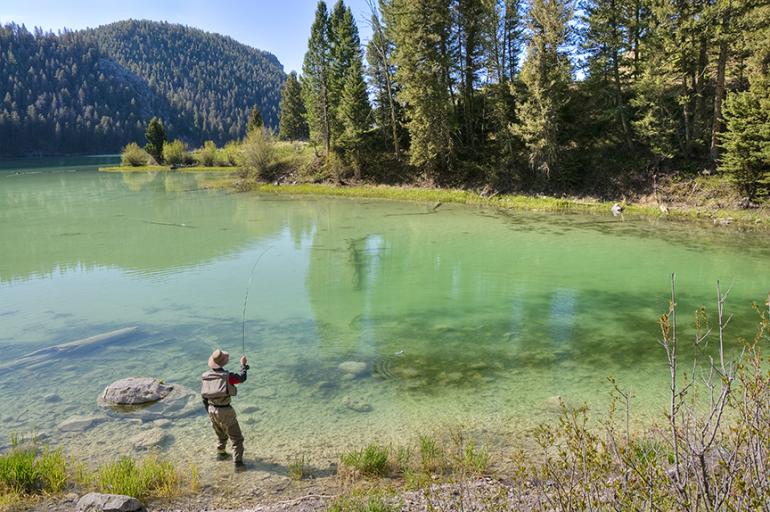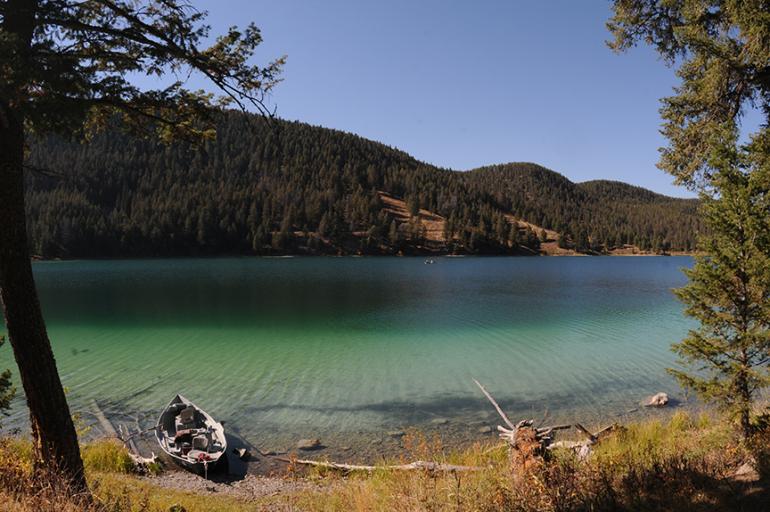End of the Season
Over my morning coffee, I sat staring out the window at the Madison River and thinking about things that needed to be done: my job, packing, cleaning, storing things for the winter—and then it occurred to me that this would be a damn fine day to go fishing. The mid-October weather had taken a turn for the better with a forecast for clear skies, light winds, and temperatures reaching the mid-60s. Over the years, I have developed an appetite and capacity for living in the present and realized that this would probably be the last chance I would have to fish before we headed south for the winter.
The Madison had not been fishing well recently, and the place I really wanted to go was Sheep Lake. The weather had been warm for a few days, but there was still snow on the ground starting about halfway up the mountains, and no way to tell how deep it was near the top. The hike to Sheep Lake is over five miles with 2,800 feet of elevation gain, and I didn’t want to slog my way up four miles only to find that I couldn’t get to the lake. I have no hesitation making an arduous hike to get to a good fishing spot, but I see hiking like dancing: mostly as a means to an end. Maybe it was a concession to my advancing age or an uncharacteristic attack of common sense, but I decided instead to drive up and give Cliff Lake a try.
Cliff Lake is a fjord-like “finger lake” in an alpine setting at around 6,500 feet, with steep banks covered by lodgepole pines right down to the water’s edge. It’s a fair-sized lake, maybe three miles long and no more than 300 yards across at its widest point. The lake is fed by several tiny streams that originate high in the Gravelly Mountains, and is drained by equally small Lake Creek which flows underground to Wade Lake before tumbling down to a slow glide through Smith Lake and on to its confluence with the West Fork of the Madison River. You can drive to Cliff Lake by taking a one-lane gravel and dirt Forest Service road that meanders six miles up from the highway and ends at a campground and boat ramp at the north end of the lake. Cliff and Wade get a lot of fishing pressure during the summer months, but the crowds of people clear out around mid-September, and by October the place is pretty much deserted.
Most of the fishing in this lake is done from boats, with the exception being a hole just west of the boat ramp below the road running along the north end of the lake. At times, and for no obvious reason, rainbow trout will congregate there, stacked up like cordwood and sometimes they can be easy to catch. It’s known locally as the “Worm Hole” because in the summer, a lot of families and kids come up to the campground and fish there with spinning rods and worms. Otherwise, fishing from the bank is problematic—bordering on impossible—because of the steep, difficult terrain along the shore. I have a high tolerance for that sort of thing, and have fished the eastern shore in the spring with moderate success, and occasionally in the fall, with very little. I’ve always chosen the eastern banks because there is obvious deep water close to shore, and letting a nymph or Wooly Bugger sink over the drop-off with a very slow retrieve can be productive.
When I got there around 10am, I took a look at the Worm Hole. No wind was blowing at the time, and in the crystal-clear water I could see there were no fish below me. I decided to walk around the west shore and fish my way back, mostly because that was the sunny side of the lake and I could still see my breath hanging in the air. I parked by the Forest Service gate at the end of the gravel road next to the empty campground, and walked along the old logging road that hugs the western shore some 20 feet above the water. I walked for maybe a half hour and then started fishing my way back along the narrow rocky beach, exposed this time of year by the low water. There is a place called “the narrows” that is a sort of neck in the lake where the water is shallow enough this late in the season to make it barely possible to get boats back and forth. I used that as my starting point.
I planned to start with a Wooly Bugger and actually tied one on—but as I walked along elevated above the lake, I saw a lot of shallow water along the edge, with a few fish here and there. On a whim, I decided to change to a flying ant imitation. I started fishing around 10:30 and at first, with no wind and the crystal-clear water, the fish spooked as I tried to quietly cast to them. I would spot a fish and give it my best sneak, staying low and behind any available cover, but the fish spotted the slightest motion of my fly rod or line every time, and would disappear in a blink. At 11am, a breeze started to blow just enough to make a small ripple on the water, and a few minutes later I caught my first fish: a 15-inch rainbow. I had made my way along the rocky shoreline toward a drowned, dead treetop on the other side of a tiny cove, casting ahead as I went, not because that section looked promising—it didn’t—but simply working the theory that you catch a lot more fish with your fly in the water than out. This cast happened to land near a little pile of sticks on the bottom and I was startled by the splash as the fish came from nowhere and slammed the flying ant. I release a lot more fish than I keep, but today I was planning on keeping fish to eat, so I cleaned this one and found that it was a female, full of eggs. I know rainbows to be spring spawners and couldn’t figure out why she would have eggs in the fall, and I felt a pang of guilt over killing a female with eggs. Remembering my favorite quote from Shakespeare, “what’s done is done,” I moved on.
Soon after that, I hooked another fish and my tippet broke off—probably because the teeth of the fish I caught had frayed it and I hadn’t bothered to check. By this time the sun had chased away the morning chill and the air was a comfortable temperature. Between casts, I had the sense to stop, look at the spectacular cliffs and hillsides around the lake, the Madison Range in the distance, and fully appreciate where I was and what I was doing.
A few minutes later I was standing over the water, 20 feet out on the trunk of a large tree that had fallen diagonally from the shore. I had cast my fly out over a drop-off and was letting it sit when I saw a good-sized rainbow swimming less than 15 feet away from me. I kept my movement to a minimum as I carefully stripped in most of my line. Using only my wrist without raising my arm, I flipped my fly over so it landed about ten feet in front of the fish. I watched the rainbow as it cruised slowly along, looked up at my fly as if to say, “oh, that looks good,” then swam up and casually ate the fly, then started to turn away. Only then did I set the hook, about a tenth of a second too soon, and hooked it in the front of the lip, where it pulled loose. Not exactly a rookie mistake, but a mistake nonetheless.
After a dry spell, I decided to tie on a #10 Dave’s Hopper and use the ant in tandem as a dropper. Almost immediately, I caught my second fish on the hopper, and it was a brightly colored 17-inch rainbow. One of the rewarding things about fishing with terrestrial flies on the surface is the aggressiveness with which trout attack them—and that aggressiveness usually carries over to the fight. It was great fun to watch the whole show in the clear water as it took line, making powerful jumps and runs before finally tiring and coming to the beach.
I started fishing my way along the shore back toward the car. Just before I got there, I saw a little trench parallel to the rocky beach, with grass and a few logs to provide cover. I made a half-hearted cast to the far side of the trench, and as I picked up the fly to cast again a decent-sized rainbow tried to eat it. I barely hooked it, pulling the hook right out of its mouth. Conventional wisdom says that if you hook a fish even slightly, it won’t bite again for a while—but I decided to try once more. This time, the fish came after the fly at top speed and missed it. I was amazed. I picked up the fly and cast again, and this time I saw the fish coming after it. I was ready and waited for the fish to eat the fly, then set the hook properly but once more it pulled loose. I made yet another cast, and the fish went for it again. Again, I either tried to set the hook too soon and missed the strike or the fish missed the fly, but I barely felt it before it came loose. I was getting frustrated—I think the fish was too. I don’t know whether the fish was bent on suicide or really angry, but I have never even heard of a fish—especially a trout—coming after a fly more than once, or possibly twice. I casted once again, and this time the fish was not to be denied. It hit that hopper as hard as I have ever seen a fish hit a fly, and this time I managed to hook it solidly. He must have had a burst of adrenaline because he gave me one hell of a fight, making a half-dozen strong, healthy runs before I finally managed to bring him to the beach. It was one of the damnedest things I have ever seen. I kept this one too; another 15-incher that fought like he was twice the size.
It is a part of human nature to be sad when something good comes to an end: a life, a marriage, a vacation, or a really good season of fly fishing. It was time to go, but still I paused for a moment to look out across the lake: to appreciate and be thankful for every minute I spent on the water, every fish I caught and some that I only saw, or hooked but didn’t catch. Most of them are still there and maybe I, or somebody else, will catch them again next year. I hope and expect to be back, but life offers no guarantees, so you can never be sure. What I do know is that I enjoyed catching a few nice fish and missing a few more. I didn’t get a tear in my eye, but it was a simultaneous feeling of satisfaction and nostalgia as I turned and climbed up the bank to the car.







